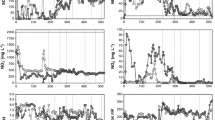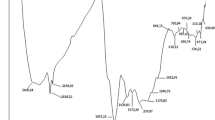Abstract
The copper industry utilizes significant amounts of sulfuric acid in its processes, generating sulfate as waste. While sulfate-reducing bacteria can remove sulfate, it produces hydrogen sulfide (H2S) as a byproduct. This study examined the capability of a consortium consisting of Sulfobacillus thermosulfidooxidans and Sulfobacillus acidophilus to partially oxidize H2S to S° at a temperature of 45 °C. A fixed-bed bioreactor, with glass rings as support material and sodium thiosulfate as a model electron donor, was inoculated with the consortium. Formation of biofilms was crucial to maintain the bioreactor’s steady state, despite high flow rates. Afterward, the electron donor was changed to H2S. When the bioreactor was operated continuously and with high aeration, H2S was fully oxidized to SO42−. However, under conditions of low aeration and at a concentration of 0.26 g/L of H2S, the consortium was able to oxidize H2S to S° with a 13% yield. S° was discovered attached to the glass rings and jarosite. The results indicate that the consortium could oxidize H2S to S° with a 13% yield under low aeration and at a concentration of 0.26 g/L of H2S. The findings highlight the capability of a Sulfobacillus consortium to convert H2S into S°, providing a potential solution for addressing environmental and safety issues associated with sulfate waste generated by the mining industry.







Similar content being viewed by others
Data availability
Authors agree to make the data available upon reasonable request. The raw sequence involved in this study was deposited in the SRA database under the Accession Number PRJNA745216.
References
American Public Health Association (1999) Standard methods for the examination of water and wastewater, Washington, DC, USA, pp. 1–541
Ayangbenro AS, Olanrewaju OS, Babalola OO (2018) Sulfate-reducing bacteria as an effective tool for sustainable acid mine bioremediation. Front Microbiol 9:1986. https://doi.org/10.3389/fmicb.2018.01986
Bailón A (2007) An innovative biotrickling filter for H2S removal from biogas. In: Kennes C, Veiga M (eds) Biotechniques for air pollution control: proceedings of the 2nd international congress on biotechniques for air pollution control. Universidade da Coruña, Coruña, pp 215–24
Bekmezci O, Ucar D, Kaksonen A, Sahinkaya E (2011) Sulfidogenic biotreatment of synthetic acid mine drainage and sulfide oxidation in anaerobic baffled reactor. J Hazard Mater 189:670–676. https://doi.org/10.1016/j.jhazmat.2011.01.087
Buisman CJN, Janssen AJH, Van Bodegraven RJ (2003) Method for desulphurization of gases. U.S. Patent No, p 6656249
Caporaso JG, Lauber CL, Walters WA, Berg-Lyons D, Lozupone CA, Turnbaugh P et al (2011) Global patterns of 16S rRNA diversity at a depth of millions of sequences per sample. Proc Natl Acad Sci USA 108:4516–4522. https://doi.org/10.1073/pnas.100008010
Chávez C, Mora A, Cabra J, Carmona Y, Revah S, Gnecco G (2004) Biofiltración de ácidos sulfhídrico (H2S), utilizando bagazo de caña de azúcar y piedra pómez como material de soporte. Inycompe 5:1–15. https://doi.org/10.25100/iyc.v5i2.2291
Chen Z, Yang G, Hao X, Samak NA, Jia Y, Peh S et al (2021) Recent advances in microbial capture of hydrogen sulfide from sour gas via sulfur-oxidizing bacteria. Eng Life Sci 21:693–708. https://doi.org/693-708
Clark DA, Norris PR (1996) Oxidation of mineral sulphides by thermophilic microorganisms. Min Eng 9:1119–1125. https://doi.org/10.1016/0892-6875(96)00106-9
Cotoras D, Viedma P (2011) A rapid and simple method for detecting active acidophilic microorganisms in copper bioleaching processes. In Proceedings of the 6th international seminar on copper hydrometallurgy. https://www.biohidrica.cl/pdfs/lixkit_11hdc.pdf
Ding JN, Jian GAO, Wu XL, Zhang CG, Wang DZ, Qiu GZ (2007) Jarosite-type precipitates mediated by YN22, Sulfobacillus thermosulfidooxidans, and their influences on strain. Trans Nonferrous Met 17:1038–1044. https://doi.org/10.1016/S1003-6326(07)60222-2
Dumont E (2015) H2S removal from biogas using bioreactors: a review. Int J Energy Environ (IJEE) 65:479–498
Edgar RC, Haas BJ, Clemente JC, Quince C, Knight R (2011) UCHIME improves sensitivity and speed of chimera detection. Bioinformatics 27:2194–2200. https://doi.org/10.1093/bioinformatics/btr381
Ghauri MA, Okibe N, Johnson DB (2007) Attachment of acidophilic bacteria to solid surfaces: the significance of species and strain variations. Hydrometallurgy 85:72–80. https://doi.org/10.1016/j.hydromet.2006.03.016
Golovacheva RS, Karavaiko GI (1979) Sulfobacillus—a new genus of spore-forming thermophilic bacteria. Microbiol (English translation Mikrobiologiya) 48:658–665
Hovell I, Lacerda R, Madeiros A (2007) The use of EDTA in alkaline zinc acetate solutions as a trapping mixture for hydrogen sulphide. PDPETRO, Campinas, pp 1–8
Huisman JL, Schouten G, Schultz C (2006) Biologically produced sulphide for purification of process streams, effluent treatment and recovery of metals in the metal and mining industry. Hydrometallurgy 83:106–113. https://doi.org/10.1016/j.hydromet.2006.03.017
Hurtado C, Viedma P, Cotoras D (2018) Design of a bioprocess for metal and sulfate removal from acid mine drainage. Hydrometallurgy 180:72–77. https://doi.org/10.1016/j.hydromet.2018.07.006
Jaber MB, Couvert A, Amrane A, Le Cloirec P, Dumont E (2017) Hydrogen sulfide removal from a biogas mimic by biofiltration under anoxic conditions. J Environ Chem Eng 5:5617–5623. https://doi.org/10.1016/j.jece.2017.10.029
Janssen AJH, Ruitenberg R, Buisman CJN (2001) Industrial applications of new sulphur biotechnology. Water Sci Technol 44:85–90. https://doi.org/10.2166/wst.2001.0471
Kaksonen AH, Puhakka JA (2007) Sulfate reduction based bioprocesses for the treatment of acid mine drainage and the recovery of metals. Eng Life Sci 7:541–564. https://doi.org/10.1002/elsc.200720216
Krayzelova L, Bartacek J, Kolesarova N, Jenicek P (2014) Microaeration for hydrogen sulfide removal in UASB reactor. Bioresour Technol 172:297–302. https://doi.org/10.1016/j.biortech.2014.09.056
Krayzelova L, Bartacek J, Díaz I, Jeison D, Volcke EI, Jenicek P (2015) Microaeration for hydrogen sulfide removal during anaerobic treatment: a review. Rev Environ Sci Biotechnol 14:703–725. https://doi.org/10.1007/s11157-015-9386-2
Li Q, Sand W (2017) Mechanical and chemical studies on EPS from Sulfobacillus thermosulfidooxidans: from planktonic to biofilm cells. Colloids Surf B 153:34–40. https://doi.org/10.1016/j.colsurfb.2017.02.009
Lin W-C, Chen Y-P, Tseng C-P (2013) Pilot-scale chemical–biological system for efficient H2S removal from biogas. Bioresour Technol 135:283–291. https://doi.org/10.1016/j.biortech.2012.10.040
Ma Y, Zhao J, Yang B (2006) Removal of H2S in waste gases by an activated carbon bioreactor. Int Biodeterior Biodegrad 57:93–98. https://doi.org/10.1016/j.ibiod.2005.10.010
Martin M (2011) Cutadapt removes adapter sequences from high-throughput sequencing reads. EMBnet J 17:10–12. https://doi.org/10.14806/ej.17.1.200
McQuaker R, Fung T (1975) Determination of total sulfur and total phosphorous in soils using fusion with alkali metal nitrates. Anal Chem 47:1462–1464
Mojarrad Moghanloo GM, Fatehifar E, Saedy S, Aghaeifar Z, Abbasnezhad H (2010) Biological oxidation of hydrogen sulfide in mineral media using a biofilm airlift suspension reactor. Bioresour Technol 101:8330–8335. https://doi.org/10.1016/j.biortech.2010.05.093
Morales M, Silva J, Morales P, Gentina JC, Aroca G (2012) Biofiltration of hydrogen sulfide by Sulfolobus metallicus at high temperatures. Water Sci Technol 669:1958–1961. https://doi.org/10.2166/wst.2012.402
Norris PR, Clark DA, Owen JP, Waterhouse S (1996) Characteristics of Sulfobacillus acidophilus sp. Nov. and other moderately thermophilic mineral-sulphide-oxidizing bacteria. Microbiology 142:775–783. https://doi.org/10.1099/00221287-142-4-775
Pandey RA, Malhotra S (1999) Desulfurization of gaseous fuels with recovery of elemental sulfur: an overview. Crit Rev Environ Sci Technol 29:229–268. https://doi.org/10.1080/10643389991259236
Pokorna D, Zabranska J (2015) Sulfur-oxidizing bacteria in environmental technology. Biotechnol Adv 33:1246–1259. https://doi.org/10.1016/j.biotechadv.2015.02.007
Quast C, Pruesse E, Yilmaz P, Gerken J, Schweer T, Yarza P et al (2013) The SILVA ribosomal RNA gene database project: improved data processing and web-based tools. Nucleic Acids Res 41:D590–D596. https://doi.org/10.1093/nar/gks1219
Ramos I, Peña M, Fdz-Polanco M (2014) Where does the removal of H2S from biogas occur in microaerobic reactors? Bioresour Technol 166:151–157. https://doi.org/10.1016/j.biortech.2014.05.058
Rattanapan C, Ounsaneha W (2012) Removal of hydrogen sulfide gas using biofiltration—a review. Walailak J Sci & Tech 9:9–18
Rattanapan C, Kantachote D, Yan R, Boonsawang P (2010) Hydrogen sulfide removal using granular activated carbon biofiltration inoculated with Alcaligenes faecalis T307 isolated from concentrated latex wastewater. Int Biodeterior Biodegrad 64:383–387. https://doi.org/10.1016/j.ibiod.2010.04.005
Rodríguez I, Aguilera I, Pérez RM, Marañón A (2010) Determinación de sulfato por el método turbidimétrico en aguas y aguas residuales. Validación del método. Rev Cuba Quím 223:39–44
Saikia S, Lens PN (2020) Synthesis and application of sulfur nanoparticles. In: Lens PNL (ed) Environmental technologies to treat sulphur pollution: principles and engineering, 2nd edn. IWA Publishing, London, pp 445–475
Schloss PD, Westcott SL, Ryabin T, Hall JR, Hartmann M, Hollister EB, Lesniewski RA, Oakley BB, Parks DH, Robinson CJ, Sahl JW, Stres B, Thallinger GG, Van Horn DJ, Weber C (2009) Introducing mothur: open-source, platform-independent, community-supported software for describing and comparing microbial communities. Appl Environ Microbiol 75:7537–7541. https://doi.org/10.1128/AEM.01541-09
Skolnik A, Heise CW (2017) Hydrogen sulfide. In: Brent J, Burkhart K, Dargan P, Hatten B, Mégarbane B, Palmer R, White J (eds) Critical care toxicology. Springer, Cham, pp 1963–1971
Tóth G, Nemestóthy N, Bélafl-Bakó K, Vozik D, Bakonyi P (2015) Degradation of hydrogen sulfide by immobilized Thiobacillus thioparus in continuous biotrickling reactor fed with synthetic gas mixture. Int Biodeterior Biodegrad 105:185–191. https://doi.org/10.1016/j.ibiod.2015.09.006
Tsaplina IA, Zhuravleva AE, Egorova MA, Bogdanova TI (2010) Response to oxygen limitation in bacteria of the genus Sulfobacillus. Microbiology 79:13–22. https://doi.org/10.1134/S0026261710010029. Krasil’nikova EN, Zakharchuk L MKondrat’eva TF
Valdés F, Camiloti PR, Rodriguez RP, Delforno TP, Carrillo-Reyes J, Zaiat M, Jeison D (2016) Sulfide-oxidizing bacteria establishment in an innovative microaerobic reactor with an internal silicone membrane for sulfur recovery from wastewater. Biodegradation 27:119–130. https://doi.org/10.1007/s10532-016-9760-y
Vikrant K, Kailasa SK, Tsang DC, Lee SS, Kumar P, Giri BS, Kim KH (2018) Biofiltration of hydrogen sulfide: trends and challenges. J Clean Prod 187:131–147. https://doi.org/10.1016/j.jclepro.2018.03.188
Worthington MJ, Kucera RL, Chalker JM (2017) Green chemistry and polymers made from sulfur. Green Chem 19:2748–2761. https://doi.org/10.1039/C7GC00014F
Yilmaz P, Parfrey LW, Yarza P, Gerken J, Pruesse E, Quast C et al (2014) The SILVA and all-species living tree project (LTP) taxonomic frameworks. Nucleic Acids Res 42:D643–D648. https://doi.org/10.1093/nar/gkt1209
Zhang B, Wang Y, Huang S, Hu H, Yuan H, Wu X, …, Tang X (2022) Removal of H2S in an extremely acidic-biotrickling filter: evaluation of removal performance and characterization of microbial communities. J Environ Chem Eng 10:108504. https://doi.org/10.1016/j.jece.2022.108504
Acknowledgements
We thank Dra. Blanca Escobar, Facultad de Ciencias Físicas y Matemáticas, Universidad de Chile, for donating the cultures of Sulfobacillus thermosulfidooxidans and Sulfobacillus acidophilus.
Author information
Authors and Affiliations
Contributions
RR contributed to conceptualization, data curation, formal analysis, investigation, methodology and writing—original draft. PV participated in formal analysis, funding acquisition, methodology, project administration, resources, software, supervision, validation, visualization, writing—original draft and writing—review & editing. DC conducted conceptualization, data curation, formal analysis, funding acquisition, investigation, methodology, project administration, resources, software, supervision, validation, visualization, writing—original draft and writing—review & editing.
Corresponding author
Ethics declarations
Conflict of interest
No conflict of interest declared.
Additional information
Publisher’s Note
Springer Nature remains neutral with regard to jurisdictional claims in published maps and institutional affiliations.
Rights and permissions
Springer Nature or its licensor (e.g. a society or other partner) holds exclusive rights to this article under a publishing agreement with the author(s) or other rightsholder(s); author self-archiving of the accepted manuscript version of this article is solely governed by the terms of such publishing agreement and applicable law.
About this article
Cite this article
Romero, R., Viedma, P. & Cotoras, D. Biooxidation of hydrogen sulfide to sulfur by moderate thermophilic acidophilic bacteria. Biodegradation 35, 195–208 (2024). https://doi.org/10.1007/s10532-023-10049-y
Received:
Accepted:
Published:
Issue Date:
DOI: https://doi.org/10.1007/s10532-023-10049-y




